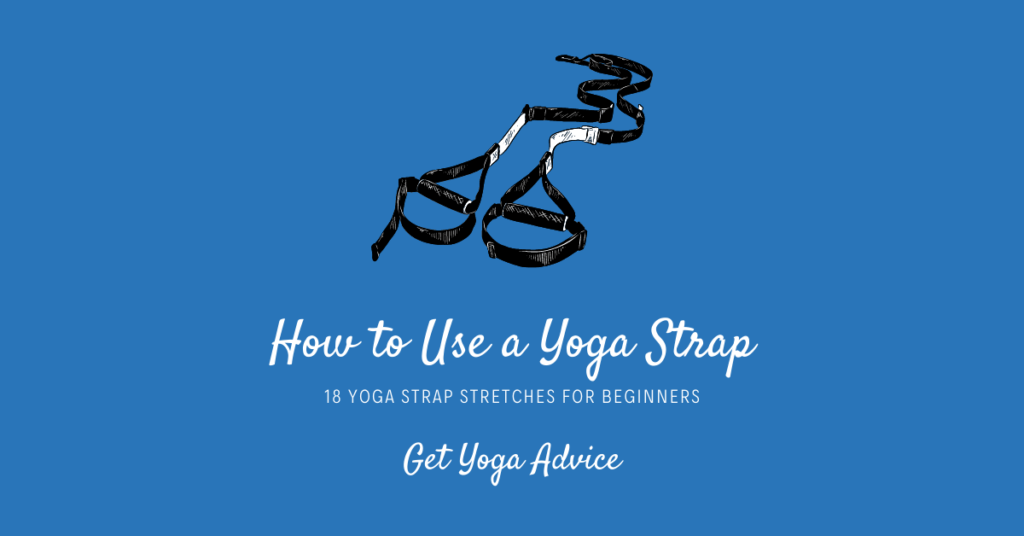A yoga strap is a useful yoga accessory that every beginner should have. While you’re working on increasing your strength and flexibility, a yoga strap makes poses more accessible and helps advance your practice.
Let’s take a closer look at why this simple nylon strap is so beneficial and 18 different ways to use one.
Contents
- 1 Why Use a Yoga Stretching Strap?
- 2 18 Beginner Yoga Strap Stretches
- 2.1 1. Binds
- 2.2 2. Bind Variations
- 2.3 3. Boat
- 2.4 4. Bow
- 2.5 5. Bound Angle
- 2.6 6. Chaturanga
- 2.7 7. Cow Face Arms
- 2.8 8. Crow
- 2.9 9. Hero
- 2.10 10. King Pigeon
- 2.11 11. Legs Up the Wall
- 2.12 12. Seated Forward Fold
- 2.13 13. Reclining Big Toe
- 2.14 14. Seated Side Stretch
- 2.15 15. Tree
- 2.16 16. Triangle
- 2.17 17. Warrior II
- 2.18 18. Warrior III
- 3 Final Word on Yoga Strap Stretches
Why Use a Yoga Stretching Strap?
Yoga props come in handy no matter how much of a yoga enthusiast you are. While yoga belts and blocks are extremely helpful, a strap is a much more effective way to work on flexibility, and they’re super easy to take with you to yoga class. Here are some of the key benefits:
They keep you in alignment
Accessories like yoga stretching straps and yoga blocks are ideal for helping you maintain alignment during poses. Some people focus so much on the positioning of the pose that they neglect to make sure their legs, knees, hips, and spine are properly aligned.
It takes some practice to get in tune with your body enough to get every pose just right. In the meantime, a yoga stretch strap can help you work toward your goal.
They help you improve
Mastering poses is not the overall goal of yoga, but once you get stronger and increase your stamina, you can start moving on to some that are more complicated. Having that little bit of extra support is very motivating, and can inspire you to try poses you weren’t sure of.
Use the stretch out strap for difficult poses, and keep practicing, maintaining proper alignment. Then, when you feel ready, remove the strap to execute the full pose without assistance.
They’re great for those with some experience too
If you have some experience but are looking to get more out of your poses, yoga stretch straps are a good way to get deeper into your stretches. They give you an idea of what each pose can feel like when you push it to the next level of yoga practitioner.
18 Beginner Yoga Strap Stretches
Here are 18 yoga stretches to try and how using a yoga strap makes them better.
1. Binds
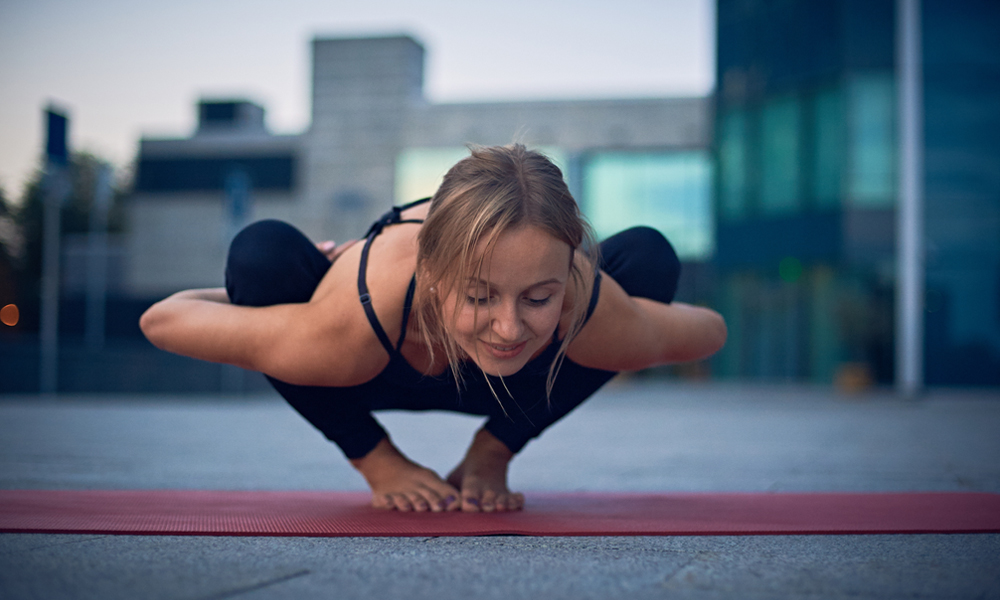
Source: canva.com
These are great shoulder stretches, but they require a lot of flexibility and a lot of people work them into their routine without using the correct alignment. A strap helps you improve your flexibility without sacrificing the fine points of the pose.
One way to use a strap is by starting in Warrior II, right foot facing forwards. Bring your right hand down to your right foot. Place the strap under your right leg, keeping one end in your right hand and the other in your left. Lift your left hand to the sky, using the strap to keep your body in proper alignment.
2. Bind Variations
If you’re doing a Bind variation to poses like Reverse Warrior or Standing Forward Fold, the hands are placed behind the back to open the chest and get a deeper stretch. This only works if your shoulders and neck are loose and you have the range of motion required to do it. A yoga strap helps you safely get your hands into the right position without risking any strain or sacrificing your alignment.
3. Boat
It can be tricky to keep your alignment correct when in this yoga pose. Your back and legs should be straight with your arms alongside your legs. If you don’t have a strong core, keeping your back straight when your legs are lifted can be very difficult. A yoga strap gives you just a little bit of support while still challenging your abs. It also forces you to lift your chest, maintaining proper position.
To do it, place the strap under the balls of your feet, legs bent. Then, start straightening your legs, extending the lower back. Push into the strap with your feet, keeping the spine straight.
4. Bow
Here’s a great pose for beginners to improve shoulder movement and prepare for more complex poses in the future. Using a yoga strap gives your arms more length so you can reach further back without pushing your body farther than it’s ready to go.
To do it, lie on your stomach on your mat. Bend your knees to bring your feet up and place the strap around your ankles, holding on to both ends. Move your hands as close to your feet as you can. Point your toes, shifting the strap from your ankles to the tops of your feet. Then, lift your knees off the mat.
5. Bound Angle
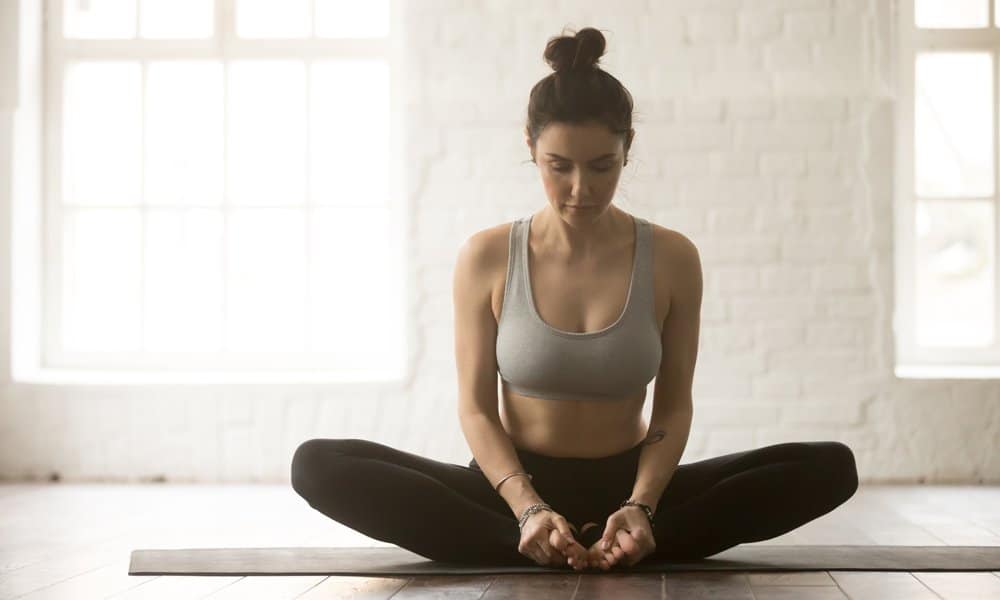
Source: canva.com
This is also called the Butterfly Pose and can be challenging to beginners because you have to focus on opening the hip flexors and maintaining a straight back. Using a strap with this pose supports your back and helps you maintain good posture while pulling your heels in closer to deepen the stretch.
Sit up straight with your heels touching, paying special attention to your spine. Place the strap around your feet, pulling it tighter until you feel the stretch in your heels and lower back. To go deeper, bring your feet in toward you.
6. Chaturanga
People try a lot of different things to make this pose easier, but it’s really hard to keep the posture correct with most modifications. A yoga strap can help. Because this pose requires core and upper body strength, it’s a little tricky for beginners. A yoga strap helps you maintain the proper position which allows you to develop the muscle strength you need to eventually do the pose on your own.
To do it, place the strap around your arms, just above your elbows. Keep it taut around your body to hold your elbows close to your sides. Get into plank position with the strap at chest level. Hands should be at about the mid-rib area, holding the chest up. If the pose is too difficult to do on your toes, you can use knees to make it a bit easier.
7. Cow Face Arms
This pose is really difficult if your shoulders aren’t loose. You have to be able to lift the right arm up to the sky and bend it behind your back. If you’re unable to do this, it’s hard to work up to the flexibility you need to execute the pose. A yoga strap allows your hands to connect behind your back without actually touching, helping you release the tightness in your shoulders, and execute the pose.
To do it, sit and lift your right arm above your head, holding the strap. Bring your left arm back and grab the other end of the strap. Move your hands as close together as you can without sacrificing your yoga posture.
8. Crow
The Crow is tricky for a lot of people, usually because their alignment is off which can make them feel like they’re going to fall. Using a yoga strap to help you keep your arms in toward your body is hugely beneficial.
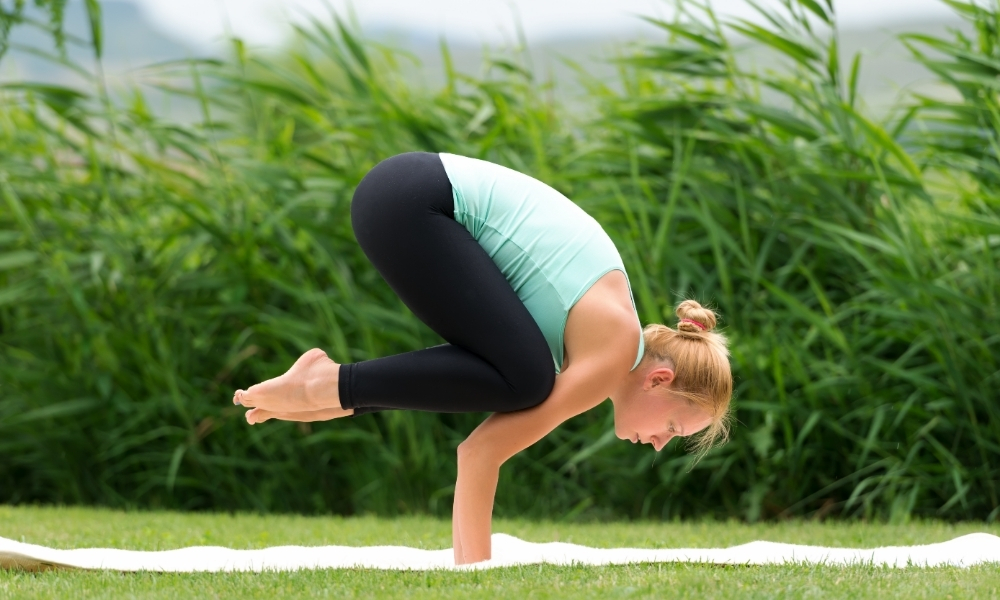
Source: canva.com
Wrap the yoga strap around your upper arms, just tight enough to keep them in place without making you uncomfortable. Then, complete the pose. This arm balance pose is pretty advanced, so don’t attempt it until you have a bit of experience and the upper arm strength to pull it off, but don’t be afraid of it when you are ready. Just use your strap to help guide you.
9. Hero
This is a basic pose but it can be hard to get the alignment just right, particularly if you have tight muscles in the legs and hips. A strap keeps the knees together so you get the most out of the posture.
Get down on your knees, toes untucked. Wrap the strap around your thighs then spread your feet apart just enough to sit between them. Pull the strap to hold your thighs together, but not so tight that you’re uncomfortable.
10. King Pigeon
This is a difficult pose to master, and a yoga strap can be essential in helping you learn. Keeping alignment is difficult, and your quads have to be strong and loose. The strap adds length to your arms and helps you keep your hips in the proper position.
King Pigeon starts with Pigeon pose. Begin by getting into a split position, with one leg positioned behind you and the other bent at the knee with your foot in front. The back leg should be flat on the floor with the foot pointing straight back. Square your hips, using a yoga block or bolster if needed.
Slowly bend your back leg in, lifting the foot toward the head and keeping your knee on the ground. Lift the yoga strap overhead and over the back foot, using it to pull your foot closer to your body. This is a very advanced pose but, as you gain more experience and you want to push your yoga practice to the next level, a yoga strap makes that possible.
11. Legs Up the Wall
Although this is considered a restorative pose, it can be a little challenging for beginners. Using a yoga strap gives your thighs extra support and may help keep your legs from sliding down the wall. That way, you can relax your body and get the full benefits of restorative yoga.
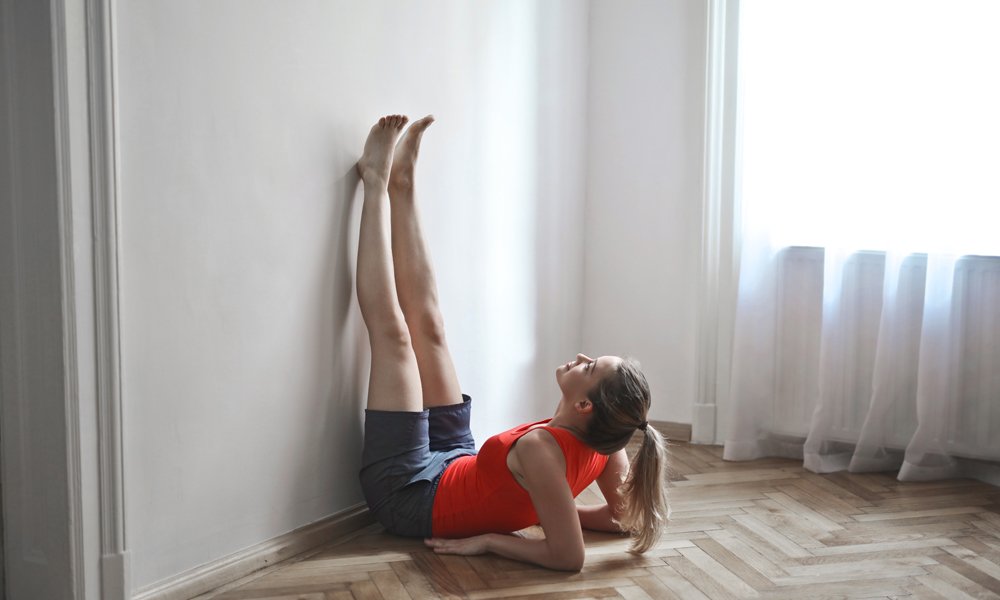
Source: canva.com
To get into position, start with one hip against the wall with your body turned sideways. Lay down on the floor and slowly lift your legs up the wall, keeping your buttocks as close to the wall as possible, like it’s the seat of a chair. Once you’re in position, wrap the yoga strap around your legs tight enough to support them. Then, relax, breathe, and enjoy the pose.
12. Seated Forward Fold
Seated forward fold is an effective way to stretch tight hamstrings, but a lot of people have a hard time getting their alignment right. Because this pose requires you to touch your feet or legs with your hands, a lot of people round their backs when doing it, which is incorrect. By using a yoga strap, you maintain proper alignment and get a much deeper stretch.
Sit down on your yoga mat. Bend your knees and place the strap under the balls of your feet. Straighten your legs and flex your feet. Then, fold your body over your legs when you exhale, using the strap to keep your spine straight. You don’t have to bend over too far, just until you feel the stretch.
13. Reclining Big Toe
This is another deep hamstring stretch that is very difficult to do without a yoga strap unless you’re extremely flexible. A strap gives your arms extra length, allowing you to hold on to your feet or legs without rounding your back or bending your knee.
Lie down on your back and bend your knee to your chest. Place the strap under the ball of your foot. Hold on to both ends of the strap and straighten your leg. As you’re doing so, let go of a little bit of the strap to adjust so you’re lying down flat with your shoulders on the ground.
14. Seated Side Stretch
The Easy Seated Side Stretch is one of the best stretches for tight shoulders, but beginners don’t always have the range of motion and end up sinking into their chest. A strap is a great tool to counter this.
Hold the strap in front of you with your hands about an arms-length apart. Lift the strap straight up over your head. Keep your elbows straight. If you can’t, try increasing the distance between your hands until you’re comfortable. Then, use the strap to maintain the proper posture as you bend to the side.
15. Tree

Source: canva.com
This is a beginner pose that is generally pretty easy but can be hard for people who have tight hips or don’t have good balance. While it’s tempting and might feel natural, you should never rest your foot on your knee when doing Tree pose. Instead, use a yoga strap to give you the extra support you need.
Start in Mountain pose, wrapping the strap around your foot. Shift your weight to the other leg, using your core muscles to lift the leg up, bending it toward your chest. Rest your foot on the inner thigh of the opposite leg, supporting it with the strap.
16. Triangle
An important part of Triangle pose is to keep the body lined up. Some people tilt the pelvis because the hips naturally come forward in the pose. Using a yoga strap helps promote awareness of what your body is doing so you can maintain proper alignment.
Begin with your legs spread apart, feet facing forward. Then, position your left foot so it faces your yoga mat. Wrap your strap around the right foot and pull it up to your left thigh. Enter the pose by bending your body over your front leg, lifting the right arm above your head toward the ceiling. If the strap comes loose, you’re probably tilting your hip. Readjust to maintain proper alignment.
17. Warrior II
Using a yoga strap is a great way to keep your arms level when doing Warrior II. The strap guides your arms and keeps them level with your shoulders, supporting them while in position.
Start with your legs spread apart, one in front of the other. Take your front foot and turn it to the top of the mat, slightly wider than you did for the Triangle pose. Bend the front knee, then lift your arms and face forward. Place the strap over your shoulders with one end in each hand. Lift until it touches the back of your shoulders, extending it straight along from one arm to the other.
18. Warrior III
This can be a tricky pose to do unsupported, which is why using a strap is so beneficial. Because you’re bending forward while also keeping your chest lifted, it’s hard to keep your balance. A strap can give you a bit of traction.
Get into Mountain pose with the strap under your left foot, holding it behind your back. Shift your weight to your right leg, hinging forward while engaging your core. Lower yourself to a 90-degree angle as you lift the left leg into the air. Hold onto the strap, flexing the toes to maintain proper alignment and balance.
Final Word on Yoga Strap Stretches
A yoga or infinity strap is a great investment for a beginner and can help with yoga practice in a variety of ways. Whether you’re just learning how to do beginner-friendly poses or are ready to move on to something more challenging, a Gaiam yoga strap or any other brand gives you a little bit of extra support and helps significantly with stretching and alignment.
One of the best things about using a yoga strap is that it helps you ease into poses you might not have the flexibility for. With continued practice, you will see your strength and stamina improve as your body adjusts to taking on more complicated poses.

